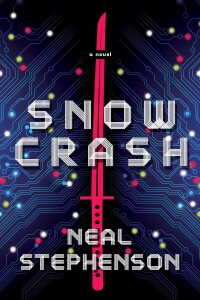 Christopher White wrote this review.
Christopher White wrote this review.
Originally published in 1995, written (presumably) in the late ’80s and early ’90s, Snow Crash is being republished in a variety of formats and editions, including a signed and numbered limited edition hardcover run of 500. This treatment bespeaks the elevated status both author and book hold for a certain audience. In the interest of candor, I cannot claim to be among the cohort of intense fans, and have just read Snow Crash for the first time (in its uncorrected pre-publication form) for this essay.
One attribute that gives the new edition a certain frisson is that, while no exact date is given for the novel’s action, the rough ages and birthdates for certain of the major characters peg the time frame as being the early years of the new millennium – in other words, now. The main character has adopted the witty, if obvious, name of Hiro Protagonist. He is presented as born in the early 1970s; at the time of the story he is in his mid-thirties. Hiro is the quintessential hacker and slacker. He parted company with a business founded by a group of computer programmers before it generated vast wealth, and now freelances as a hacker sucking up bits of information for the CIC, an entity that combines the attributes and functions of the CIA and the Library of Congress. At least, that is how it is presented in Snow Crash. With the benefit of knowing what actually happened during those two decades since the book was written, it is easy to see the connection to Wikipedia and Google.
When the story begins Hiro is augmenting his meager income doing one of the more dangerous jobs in Stephenson’s dystopian projection of our early twenty-first century world … pizza delivery. What makes it so fraught with peril is not only the deteriorating infrastructure and general lawlessness that can impede quick delivery, but that pizza delivery is now the province of the Mafia, whose capo di capo, Uncle Enzo, personally guarantees delivery within thirty minutes. Families lucky enough to have their large pie with peppers and sausage arrive late are showered with riches to compensate for their pain and suffering. Pizza delivery guys who cause Uncle Enzo this embarrassment and added cost suffer the consequences. No one messes with the Mafia. Hiro is good at it in part because his mixed ancestry (African American soldier father, Asian mother) led him to become an expert Samurai swordsman. In the wild ride that follows, Stephenson introduces Y.T., a valley girl and skateboard riding “Kourier” with daddy issues, who saves the day for Hiro and earns the respect and interest of Uncle Enzo in the process.
There’s a psychopathic Aleut motorcyclist with a recovered Soviet nuke for a sidecar; there’s a cult leader who is roughly equal parts Jim Jones, L. Ron Hubbard, and Bill Gates; there are Eastern European punk rockers; there’s the Metaverse (think the Web on steroids) and burbclaves (think gated communities that have seceded from all other political connections); in short, don’t look for a conventionally believable character or plotline.
What Stephenson does in Snow Crash is combine the better attributes of an action adventure SF page turner (cyber punk division) with some fairly dense and intriguing explorations into religion, language and socio-political history and theory. Depending on a given reader’s taste, some of this may seem too tangential, but various readers will no doubt find particular threads “tangential” that other readers find central to their enjoyment of the book. The reader will contemplate such ideas as the relationship between the biblical story of the Tower of Babel and Sumerian religion and linguistics; the creation stories of many major religions, ancient and current, and computer languages; the plausible way government and corporations might blend into “franchulates” (another of the many neologisms the reader will encounter and decode along the way). The core of the story explores the scary notion that a certain virus could infect both biological and computational hosts, leading to virtually complete control of the population by a single dictator.
This is neatly summarized in an exchange between our Hiro and his former (and Hiro hopes future) lover, a fellow hacker seeking in her own way to unravel and stop the spread of this postmodern plague.
“Hiro puts his head in his hands. He’s not exactly thinking about this; he’s letting it ricochet around in his skull, waiting for it to come to rest. ‘Wait a minute, Juanita. Make up your mind. This Snow Crash thing — is it a virus, a drug, or a religion?’
Juanita shrugs. ‘What’s the difference?’ “
Whatever this Snow Crash thing is, Snow Crash the novel is a clever and enjoyable piece of cyberpunk fiction by one of the leading authors in a genre that includes the likes of Bruce Sterling and William Gibson. Those of you who are already fans of Stephenson might well consider investing in one of the limited edition hardcover editions about to hit the market. Those of you who are not already fans should consider picking up a paperback version and delving into Stephenson’s imaginative and perceptive (if not entirely accurate) early nineties view of what our early third millennium life might be like. And who is to say that in another half century or so Stephenson’s vision might not prove to be more prescient than it might today?
(Subterranean Press, 2008)
